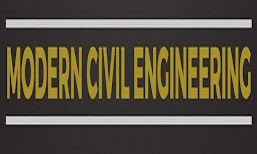As you go read my previous blog,we talked about Beams,Load and their types
and Shear Force and Bending Moment Diagram.In these blog we will talked about the bending stresses in the beam.
When some external load or force act on the beam,shear force and bending moment are produced in the beams. The beams will undergo deformation due to these forces and offer a resistance or stresses against these deformation.Thus the stresses produced due to bending are called as bending stresses.
Pure bending( Simple bending):The stress which occur due to only constant bending moment (shear force is zero ) subjected to a beam over entire length is called pure bending.
But in actual pratice bending moment is varies from section to section of beam and shear force is also not zero.The shear force is zero only when the bending moment is maximum.Thus the condition of simple or pure bending is satisfied at such section. Hence the stresses produced when BM is maximum is free from the shear force.
Assumptions made for simple bending:
and Shear Force and Bending Moment Diagram.In these blog we will talked about the bending stresses in the beam.
When some external load or force act on the beam,shear force and bending moment are produced in the beams. The beams will undergo deformation due to these forces and offer a resistance or stresses against these deformation.Thus the stresses produced due to bending are called as bending stresses.
Pure bending( Simple bending):The stress which occur due to only constant bending moment (shear force is zero ) subjected to a beam over entire length is called pure bending.
But in actual pratice bending moment is varies from section to section of beam and shear force is also not zero.The shear force is zero only when the bending moment is maximum.Thus the condition of simple or pure bending is satisfied at such section. Hence the stresses produced when BM is maximum is free from the shear force.
Assumptions made for simple bending:
- The material of beam is homogenous(material is of same kind)and isotropic(elastic properties in all direction is equal)
- In both tension and compression, the value of young modulus of elasticity.
- The beam is straight intially and bend all longitudinal filaments into circular arc with common centre of curvature.
- Radius of curvature is large compared to dimensions of cross section.
- Each layer is free to expand or contract.
Theory and diagram of simple bending:
Consider a section of beam is subjected to simple bending.Now take a small section of these beam AB and CD normal to axis of beam as shown in figure.
Before bending the length of all layer remain same but after bending the all layer do not remain of same length. The upper layer AC changes to A'C' by shorten its length. Similarly the BD changes to B'D' by increasing the length. Thus some layer get shortened and other are enlongated. But we observed a layer between the top and bottom of beam which neither shorten or enlarged. These layer is known as neutral axis or surface. These layer is shown by N-N in figure of before bending and by N'-N' in figure of after bending.
Before bending the length of all layer remain same but after bending the all layer do not remain of same length. The upper layer AC changes to A'C' by shorten its length. Similarly the BD changes to B'D' by increasing the length. Thus some layer get shortened and other are enlongated. But we observed a layer between the top and bottom of beam which neither shorten or enlarged. These layer is known as neutral axis or surface. These layer is shown by N-N in figure of before bending and by N'-N' in figure of after bending.
Observation: As the decrease in length is maximum in top layer. As we move toward the neutral axis there is decrease in length. At N-N axis, ther is no change thus top layer undergo the compression stresses.The compression forces are maximum at top layer. Similarly the increase in length is maximum at bottom layer. As we move toward the neutral axis, the increase in length decreases Thus the bottom layer undergo the tensile forces.
Expression for bending stress: Consider a small section dx of a beam subjected to bending. A part dx undergo deformation due to bending stress as shown in figure. Let A'B' and C'D' meet at O.
Suppose R = radius of neutral layer N'N'
The relation is given by
σ/y = E/R
M/I = σ /y =E/R
Where M = External moment
I = Moment of interia
σ/y = E/R
Where σ is bending stress
y = distance of layer from neutral axis
E = Young modulus of the beam
R = radius of neutral axis from point O
Moment of Resistance: As the top layer undergo compressive stress and bottom layer undergo the tensile stress due to simple or pure bending. Some forces will be acting due to these stresses and these forces will have moment about Neutral axis NA. Thus the total moment of these forces for a section is known as Moment of Resistance for that section which is given byM/I = σ /y =E/R
Where M = External moment
I = Moment of interia













0 Comments